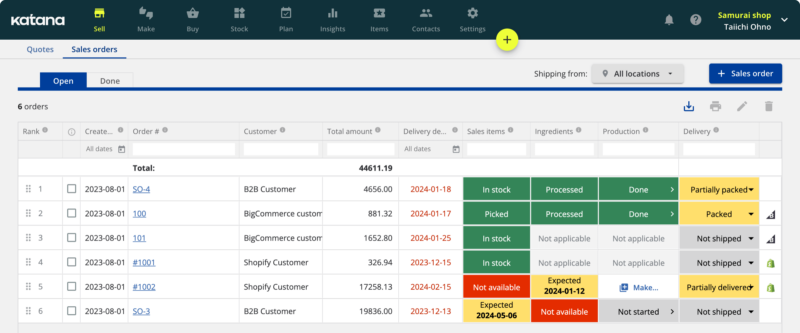5 product bundling strategies you need to be using in 2024
Here we go through the benefits of selling product bundles, and even more importantly, the strategies you can use to make the most out of them.

James Humphreys

Product bundling is a practice used by manufacturers from all kinds of industries. But a problem that unites them all is how exactly to create and manage bundles that are going to increase average order value.
There’s a knocking at the front door.
You open and the postman greets you with an ever-knowing smile. It’s like he knows what wonder lies inside your post today.
You sign off and take the box inside to be greeted by a beautiful product bundle.
What a delight.
Now comes the plain old excitement of going through the box and unwrapping each product one at a time.
The truth is that we all love buying bundles of products. Especially if they’ve been well put together.
But the thing is, creating product bundles is as much a science as it is an art. Customers react to each bundle differently, and there are good reasons why this is the case.
The complexity, synergy and pricing of your bundles can all have a critical effect on how well your bundles do.
Now, there are plenty of strategies you can use to make sure your bundle offer pays off. And we’ll get to five of the best soon enough.
Before we get to that though, let’s investigate why you should practice product bundling in the first place.
Product Bundling Benefits
So, what are bundles? And what’s the point of having them?
Well, to put it simply, product bundling involves combining several products into a package with a reduced price.
It’s a way for customers to see your products in a different light and hopefully, spend more in the process.
Product bundle examples could include basic packages, holiday sets, subscriptions boxes, product samples, and even giveaways.
To find more bundle ideas check out our blog on inventory kitting (another word for product bundle).
Otherwise, let’s jump into the benefits of bundling.
1. Increase Average Order Value
As you can imagine the first benefit to bundles is the potential for a greater average order value. In other words, your customers spend more each time they buy.
That’s because people are encouraged to spend and order more products when being offered a bundle discount. The principle is that buying products in bundles are going to save the customer money.
Now that might mean that your margins might take a slight hit, but the increase in sales should more than makeup for that.
Plus, you should be saving money on transaction costs by having a fewer number of orders.
2. Reduce Inventory
Being smart with your stock bundles means that you can move dead stock on by pairing weaker items with strong selling items.
This can help you make room in your stock room, save on carrying costs and increase product awareness for your underselling items.
Now, beware that there are dangers in matching inexpensive items with premium products. You might find these kinds of bundles not faring so well. But we’ll get to that in more detail later.
3. Simplify Marketing
Merging your items into a single SKU means you can manage and visualize your stock much more easily.
Even more importantly, though, it means that you could be doing the marketing of multiple products in one fell swoop.
So, rather than campaigning to sell ten different beauty products and accessories from your cosmetics inventory and jewelry inventory, you can sell them as a single beauty package. This way, you can save money on marketing costs and combine various campaigns into one.
Product Bundle Strategies

Put in as much effort as you can in making your product bundles feel well thought out. A handcrafted box and pretty packaging can go a long way in making your bundles an exciting purchase.
Alright so you know the reasons why product bundling can be so beneficial to business, but “how do I create product bundles” we hear you ask.
Well, the answer is fairly simple once the facts have been put into place.
There is some sound reason you can follow when putting your bundles together.
1. Put Complimentary Products Together
Bundles best work when you combine products that are often purchased together. Just put yourself in the customer’s shoes and think about which products you are most likely to buy at the same time.
So, if you are selling your handmade backpacks online, then you might want to make bundles that also include extra straps and locks.
Customers are much more likely to buy items which complement each other, and that also includes accessories and spare parts.
2. Sell Items Separately
Regardless of what bundles you create, make sure to always sell your products separately as well.
Nintendo learned that the hard way as their revenues decreased 20 percent when buying a bundle was the customer’s sole option to purchase a product.
For them, it meant a decrease in millions of units of sales, and though this might seem like an extreme case, there’s a good reason why it’s universally applicable.
After all, customers often buy bundles because they believe they are getting a discount as opposed to getting each item separately.
There’s no way they can make the comparison unless you offer them the individual products as well.
3. Use Recommendations
Upselling using e-commerce recommendations is a brilliant way to sell your product bundles.
The numbers say that 35% of all Amazon purchases come from recommendations, many of which are bundles.
The same can be done with other e-commerce platforms such as Shopify product bundles and Woocommerce product bundles. Your success largely depends on using the best themes and apps which support this feature.
But you can also recommend bundles in your banners and social media.
Just remind customers how much they are saving with these bundles, and ideally what benefit buying the products all at once gives them.
4. Pair Products Smartly
Your initial instinct might well be to pair expensive and inexpensive products together. You could get people interested in products they might otherwise have ignored, plus there’s potential to increase margins.
However, the reality is that we view the value of a product bundle as the average of its parts, rather than the sum of its parts.
That means that if one item in the bundle is significantly lower in value then customers will pick up on that and automatically lower the average in their mind. If you want to pair low and high-value items, then you need to make sure that they provide good overall value in terms of experience and congruity.
Otherwise, you might be putting people off your bundles altogether, as they feel like they are being played in some way.
If you really do want to try putting super low-value items in your bundles then make sure to focus on the benefits of the products and stop customers from thinking along monetary lines too much.
Write descriptions on how well these products go well together, and let customers know there is a good reason they are being put together.
5. Keep Bundles Nice and Simple
Simple is best.
We are overloaded with enough information as it is these days. So, making the customers job as easy as possible is going to be appreciated by them, and most likely convert to greater sales.
Complicated bundles are likely to put customers off and may even subconsciously affect the way they view your brand in a negative way.
It doesn’t matter if your product bundle is the perfect combination of twenty items for your customers. Most people just won’t put in the energy to work out why that’s the case.
Make your bundles easy to swallow and that buy button will start to look a lot more inviting!
How Do I Create Product Bundles?

Katana allows you to view your product bundle creating process from start to finish. Set up the recipe and then once the orders are rolling in you will immediately know how production is coming along with a color-coded chart.
Alright, so now you know the way to successful online sales of product bundles.
It’s not so simple as just throwing a random group of products together, but it’s certainly not rocket science either.
So, the final question is, how do you create product bundles that can be easily sold on all your sales channels?
In a way that makes your unified product lines simple to understand and buy for all your customers.
Well, the solution here comes in the form of Katana Cloud Inventory Software.
Katana lets you create product bundles, which you can track and manage without the need for additional spreadsheets.
The way it works is that you can create a product which is made of other products and unified into a single SKU.
Your bundle’s components will then be tracked automatically in real-time so that you know that your products are always available for customers.
Katana lets you know if a bundle is available through “Product availability”, and whether you have enough materials for more of them with the “Material availability”.
If either of them is running short then the block turns red, and if you are good to go then they stay green. All visually laid out for the maker’s eye.
Then the bundles can be sold through each of your sales channels, including through direct integration with platforms such as Shopify and Woocommerce. This way your inventory is synced automatically and you won’t even have to make manual adjustments.
But the point of Katana is not only to create product bundles.
It also offers you:
- On-demand access to your manufacturing costs
- Sync accounting with your QuickBooks
- Manufacturing inventory management and material inventory
- Production scheduling software functionality
- Floor-level control for manufacturing
- Integration with Shopify, Woocommerce and other ecommerce channels
- Efficient material purchasing plans
- The opportunity to ditch inefficient Excel spreadsheets forever
- A way to keep your entire business workflow on a single dashboard
This way you stop spending your days on spreadsheets and you can start focusing on your modern manufacturing business, instead.
That means you can spend a bit of extra time on creating some awesome product bundles to keep your customers coming back for more.

James Humphreys
Table of contents
Get inventory trends, news, and tips every month
Get visibility over your sales and stock
Wave goodbye to uncertainty with Katana Cloud Inventory — AI-powered for total inventory control